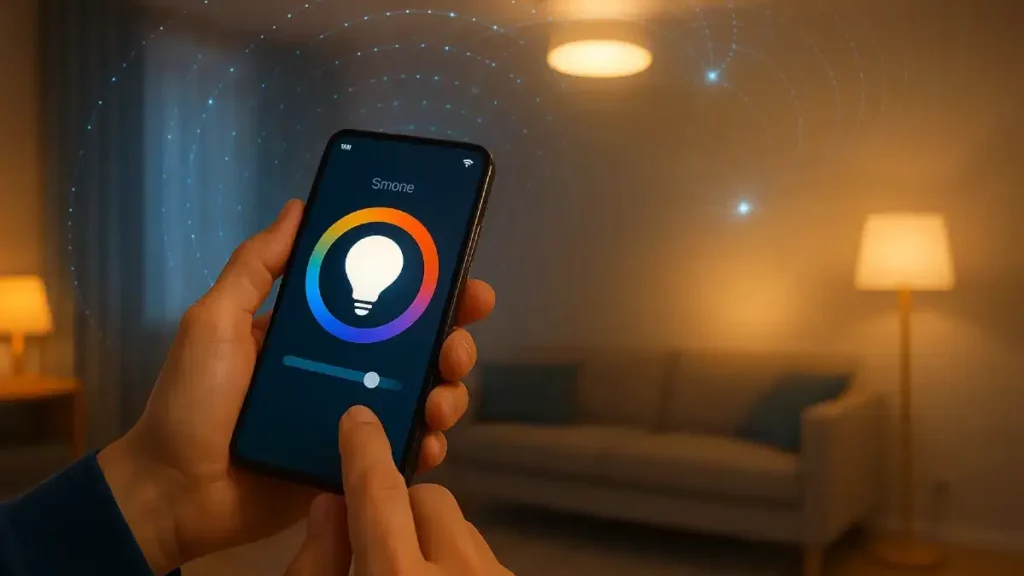Smart Lighting Systems: Illuminating the Future of Home Automation
Smart Lighting Systems: Illuminating the Future of Home Automation
Estimated reading time: 8 minutes
Key Takeaways
- Smart Lighting Systems use IoT technology for advanced control, energy efficiency, and customization of home lighting.
- Core components include smart LED bulbs/fixtures, control hubs/apps, sensors, and voice assistants, enabling remote and automated operation.
- Benefits encompass significant energy savings (up to 90% reduction compared to old bulbs), enhanced convenience, personalization (brightness, color), and integration with other smart home devices.
- Future trends involve AI-driven adaptation, improved connectivity (like Matter), and greater emphasis on sustainability and the circular economy.
- Adoption requires considering costs vs. long-term savings, compatibility with existing home wiring/fixtures, and addressing security/privacy concerns through measures like strong passwords and regular updates.

Table of Contents
Think about the lights in your home. For a long time, turning them on or off meant flipping a switch on the wall. Simple, right? But lighting has come a long way since then. Now, we have intelligent systems that can change and adapt to how we live. Welcome to the world of Smart Lighting Systems.
What are Smart Lighting Systems? They are like a team of smart lights and controls all working together in your house. They use special technology called the Internet of Things (IoT) to connect everything. This makes your home lighting easier to use, saves energy, and helps create the perfect mood. These clever systems are changing the way we think about lights, letting us control them in ways we never could before. Smart Lighting Systems mix new ideas, ease of use, and sustainable ways to help the planet all into one package.
“Imagine lights that not only illuminate but also understand and adapt to your lifestyle.”
In this post, we’ll explore these amazing systems. You’ll learn how they work, what makes them smart, and how they can make your home life better, brighter, and more efficient. Get ready to see how Smart Lighting Systems are lighting up the future of our homes.
Understanding Smart Lighting Systems
At its heart, a Smart Lighting System is a collection of smart light bulbs, fixtures, and controls that are all connected. You can set them up, tell them when to turn on or off, and control them even when you’re not home.
How are these systems different from the regular home lighting we’re used to?
- Control from anywhere: You can use your phone, tablet, or even your voice to control your lights. No need to get up!
- Automatic lights: You can set lights to turn on or off based on things like time of day, whether someone is in the room, or even sunrise and sunset.
- Works with other smart stuff: Smart lighting can connect with other smart devices in your home, like speakers or security systems, to work together.
- Saves energy and lets you choose: They use much less power, especially with LED lights, and you can pick exactly the brightness or color you want.
What parts make up a smart lighting setup?
- Smart Bulbs and Fixtures: These look like regular lights but have computer chips inside. Most use LED technology, which is super energy-efficient.
- Control Hubs or Bridges: Sometimes, you need a small box (a hub) that plugs into your internet router. It acts like the brain, helping all the lights talk to each other and to your phone. Some systems don’t need a separate hub.
- Sensors: These are like little electronic eyes and ears. Motion sensors turn lights on when someone walks by. Ambient light sensors check how much daylight there is and adjust the indoor lights.
- Mobile Apps: Special apps on your phone or tablet let you control everything, set schedules, and change settings.
- Voice Control: You can often connect your system to voice helpers like Amazon Alexa, Google Assistant, or Apple Siri to control lights just by speaking.
These components work together to create intelligent smart lighting systems that make our homes more comfortable, convenient, and efficient.
Core Components of Smart Lighting Technology
Let’s look closer at the key parts that make smart lighting work so well. These pieces of technology are what give these systems their power and flexibility.
LED Technology – The Foundation of Smart Lighting
Why are LED lights the star player in smart lighting? LED stands for Light Emitting Diode. These aren’t like the old glass bulbs with glowing wires inside. They are tiny electronic parts that make light very efficiently.
- Energy Saving: LEDs are amazing energy savers. They use up to 75% less energy than the old incandescent light bulbs. That’s a huge difference!
- Long Life: LED bulbs last a very, very long time. They can shine for 15,000 to 25,000 hours or even more. Compare that to an old bulb that might only last 1,000 hours. You won’t have to change bulbs nearly as often.
- Smart Control Friendly: Because LEDs are electronic, they work perfectly with smart controls. It’s easy to make them dim, brighten, or change color electronically.
- Lots of Colors: LEDs can easily produce bright white light, warm yellow light, and millions of different colors. This makes them perfect for setting any mood with your smart lighting.
What kinds of smart LED products can you get?
- Smart Bulbs: These look like regular bulbs and screw into your existing lamps and fixtures. They are the easiest way to start with energy-efficient lighting.
- Smart Light Strips: These are flexible strips with LEDs on them. You can stick them under cabinets, behind TVs, or along stairs for cool accent lighting.
- Smart Fixtures: These are complete light units, like ceiling lights or pendant lamps, that have smart technology built right in.
Using LED technology makes smart lighting incredibly efficient and versatile.
(Source for LED energy use: https://dominionlighting.com/smart-lighting-systems/)
Energy-Efficient Lighting Benefits
One of the biggest plus points of smart lighting is how it helps save energy. This energy-efficient lighting is good for your wallet and good for the planet.
“Save energy, save money, and save the planet – all with smarter lights.”
How do smart systems save energy?
- LED Power: As we saw, LED lights themselves use much less electricity than older types of bulbs. Just switching bulbs makes a big difference.
- Smart Controls: Smart systems reduce power use because they automatically turn lights off when they aren’t needed. Think about lights turning off when you leave a room or dimming when there’s enough sunlight.
- Dimming Saves More: When you dim your smart lights, they use even less energy. Setting lights to 50% brightness uses about half the power. Old bulbs didn’t save much energy when dimmed.
- Big Savings: Compared to old incandescent lights, smart LED systems can cut your lighting energy use by 70% to 90%! Over a year, this can add up to real savings on your electricity bill.
- Helping the Earth: Using less energy means power plants burn less fuel, which reduces your carbon footprint (your impact on climate change). Also, because LED bulbs last so long, you throw away fewer bulbs, which means less waste in landfills.
Investing in energy-efficient lighting through smart systems offers clear savings and helps protect our environment.
(Source for automated control savings: https://eoslight.com/benefits-of-smart-lighting/)
Lighting Controllers and Control Systems
How do all the smart bulbs and sensors talk to each other and listen to you? That’s the job of lighting controllers and control systems. They are the command center for your smart lighting systems.
What kinds of controllers are there?
- Hub-Based Systems: Many popular systems use a central hub or bridge. This small device connects to your home internet router. It uses special wireless signals (like Zigbee or Z-Wave) to talk to all your smart lights. Examples include the Philips Hue Bridge or Samsung SmartThings Hub. The hub makes the system reliable and often allows more complex setups.
- App-Only Systems: Some smart lights connect directly to your home’s Wi-Fi network without needing a separate hub. You control them using just a smartphone app. Examples include LIFX or Wyze bulbs. These can be simpler to set up initially.
- Voice Assistants: Smart speakers like Amazon Echo (Alexa), Google Nest (Google Assistant), and Apple HomePod (Siri/HomeKit) can act as controllers. You can connect compatible smart lights and control them simply by speaking commands.
These lighting controllers act as the “brain” of the smart lighting system. They receive your commands (from the app or your voice) and tell the lights what to do. They also manage the automatic schedules and rules you set up.
How do they communicate? Smart devices use different wireless languages, called protocols, to talk:
- Zigbee & Z-Wave: Low-power radio signals often used by hub-based systems. Good for creating a dedicated network just for smart devices.
- Bluetooth: Used for direct control from your phone when you’re nearby, or in mesh networks where devices relay signals.
- Wi-Fi: Connects directly to your home router. Easy setup but can add traffic to your Wi-Fi network.
- Thread/Matter: Newer protocols designed to make different brands of smart devices work together more easily and reliably. Matter aims to be a universal standard for connected lighting and other smart home gear.
Understanding these controllers and protocols helps you choose the right smart lighting system for your needs.
(Source for controllers as the brain: https://iottysmarthome.com/blogs/smart-home/smart-lighting-systems)
How Smart Lighting Enhances Daily Life
Smart lighting isn’t just about cool technology; it’s about making everyday life better. From setting the perfect mood to automating tasks, these systems offer real benefits.
Personalization and Convenience with Connected Lighting
Connected lighting systems give you amazing control over how your home looks and feels. You can customize your lights like never before.
- Perfect Brightness: Need bright light for cooking or reading? Easy. Want soft, dim light for watching a movie or relaxing? Just adjust the brightness level using an app or voice command.
- Right Color Temperature: Light isn’t just bright or dim; it can also be ‘warm’ (like a sunset, yellowish) or ‘cool’ (like daylight, blueish). You can change the color temperature to match the time of day—maybe cooler, energizing light in the morning and warmer, relaxing light in the evening to help you wind down.
- Millions of Colors: Many smart bulbs can produce almost any color you can imagine. Set your lights to team colors for game night, festive colors for holidays, or calming colors for meditation. The possibilities are endless.
- Create Scenes: You can save your favorite lighting settings as ‘scenes’. Maybe a “Movie Night” scene dims the main lights and turns on soft accent lighting. A “Dinner Party” scene could create a warm, inviting glow. Activate these scenes with a single tap or voice command.
These systems also add a lot of convenience to your home lighting:
- Control from Anywhere: Forgot to turn off the lights before leaving home? No problem. Just open the app on your smartphone and switch them off from wherever you are. Turn them on before you arrive home so you don’t walk into a dark house.
- Voice Commands: Hands full? Just tell your voice assistant (like Alexa or Google) to turn the lights on, off, dim them, or change their color. It feels like magic!
- Schedules: Set your lights to follow your daily routine automatically. Have them gently brighten in the morning to help you wake up, turn on specific lights when it gets dark outside, and turn off automatically at bedtime.
Connected lighting in smart lighting systems means your home lighting fits your life perfectly, offering both personalized ambiance and effortless control.
(Source for convenience factors: https://blog.mipimworld.com/guide-proptech/proptech-smart-lighting-systems-energy-efficiency-responsiveness/)
Automation and Intelligence in Automated Lighting
One of the ‘smartest’ things about smart lighting is its ability to work automatically. Automated lighting features use sensors and schedules to manage your lights without you needing to do anything.
“Let your lights think for themselves, turning on and off exactly when you need them.”
Key automated lighting features include:
- Motion Sensors: Place motion sensors in hallways, bathrooms, closets, or entryways. The lights turn on instantly when someone enters the area and turn off automatically after a period of inactivity. This is great for convenience and energy saving.
- Presence/Absence Detection: Some advanced systems can tell if people are actually present in a room (not just moving). They keep the lights on as long as someone is there and turn them off promptly when the room is empty.
- Daylight Sensing: Smart sensors can measure the amount of natural light coming into a room. They automatically dim or turn off artificial lights when there’s enough daylight, saving energy and maintaining consistent light levels.
- Geofencing: Your smart lighting system can use your phone’s location. Set it up so your lights automatically turn on when you get close to home and turn off when you leave.
- Sunrise/Sunset Syncing: Program your lights to turn on at sunset and off at sunrise automatically. Some systems can even mimic the gradual changes in natural light throughout the day, supporting your body’s natural rhythms (circadian rhythm lighting).
These automated lighting features, often managed by the lighting controllers, work together seamlessly. Imagine walking down a hallway at night, and lights automatically brighten in front of you and dim behind you. Or having your kitchen lights adjust based on the sunshine coming through the window. This intelligence makes smart lighting feel effortless and intuitive.
Integration with Smart Home Ecosystems
Smart lighting systems don’t usually live in isolation. They are often designed to work together with other smart devices in your home, creating a truly connected and automated environment.
Major smart home platforms that integrate with smart lighting systems include:
- Amazon Alexa: Control lights using Echo speakers and the Alexa app. Create routines that link lights with other Alexa-compatible devices.
- Google Home/Nest: Use Google Assistant on Nest speakers or your phone to manage lights. Set up Google Home routines for multi-device automation.
- Apple HomeKit: Control lights via Siri on iPhones, iPads, HomePods, or Apple Watches. Use the Home app to manage devices and create automations.
- Samsung SmartThings: A powerful platform that connects devices using various protocols (Zigbee, Z-Wave, Wi-Fi). Use the SmartThings app to control lights and build complex automations with sensors, locks, and thermostats.
What are the benefits of integrating connected lighting with these ecosystems?
- One Control Center: Instead of using separate apps for lights, locks, thermostats, etc., you can often manage many devices through a single interface like the Alexa, Google Home, or HomeKit app.
- Smarter Automations: Integration allows devices to trigger each other. For example:
- When your smart doorbell detects motion, your porch light turns on.
- If your smart smoke detector goes off, all the lights in the house could turn on to help you see the way out.
- When you set your security system to ‘Away’, your lights could automatically switch to a randomized pattern to make it look like someone is home.
- Adjusting your smart thermostat could trigger a change in lighting color temperature.
- Easier Control: Using voice commands through your preferred assistant (Alexa, Google, Siri) becomes a simple way to control groups of devices, including your smart lighting systems, all at once. For instance, saying “Goodnight” could turn off all lights, lock the doors, and lower the thermostat.
This level of integration makes your smart home more powerful and convenient, with connected lighting playing a crucial role in everyday scenarios. For example, lights could flash specific colors when the doorbell rings, which is helpful for people who are hard of hearing.
Future Trends in Smart Lighting Systems
Smart lighting is already impressive, but it’s constantly getting smarter and better. Let’s look at some exciting future trends that will shape the next generation of smart lighting systems.
AI-Driven Adaptation in Automated Lighting
Artificial intelligence (AI) and machine learning are making smart lighting systems much more intuitive and responsive. Soon, your lights won’t just follow commands; they’ll anticipate your needs.
“The future isn’t just bright, it’s intelligent. Lights that learn your habits and adapt.”
Future AI capabilities in automated lighting include:
- Predictive Lighting: Systems will learn your daily routines and preferences. They might automatically adjust the lights based on the time of day, your usual activities in a specific room, or even who is in the room, without you needing to program complex schedules.
- Adaptive Lighting: Imagine lights that subtly change based on your mood or biological needs. Systems might use sensors (like cameras or wearables) to detect if you’re stressed and adjust lighting to be more calming, or provide energizing light if you seem tired. They could also fine-tune lighting to better support your natural sleep-wake cycle (circadian rhythm).
- Occupancy Prediction: Instead of just detecting motion, future systems might predict when a room is likely to be occupied based on past patterns. This could pre-illuminate spaces just before you enter.
- Context Awareness: AI will help systems understand what you are doing, not just that you are there. Are you reading, watching TV, cooking, or working? The lighting could automatically adjust to the optimal settings for that specific activity.
Machine learning algorithms will continuously analyze data from sensors and user interactions to refine these predictions and adaptations, making the smart lighting systems feel truly personalized and effortless over time. This level of intelligence will push automated lighting beyond simple triggers to become truly adaptive environments.
Advanced Connectivity for Connected Lighting
The way smart devices talk to each other is also getting better, leading to more reliable and capable connected lighting systems.
Emerging connectivity trends include:
- 5G Integration: While most smart home devices don’t need the high speed of 5G themselves, the overall improvement in network speed and capacity from 5G could make cloud-based smart home controls faster and more responsive.
- Mesh Network Improvements: Technologies like Zigbee, Z-Wave, and Thread already use mesh networking (where devices relay signals for each other). Future improvements will make these networks even more robust, covering larger homes more reliably and handling more devices without slowdowns.
- Edge Computing: Instead of relying solely on the internet (the cloud) for processing commands and running automations, more intelligence will move to devices within the home (the “edge”). This reduces delays (latency), means basic functions can work even if the internet is down, and can improve privacy as less data needs to leave the home.
- Interoperability Standards (Matter): Matter is a new standard designed to make smart home devices from different companies work together seamlessly. This means you’ll have more choice in smart lighting products, knowing they will likely work with your existing setup or preferred control system (like Alexa, Google Home, or HomeKit). Setting up new connected lighting devices could become as simple as scanning a code.
These advancements promise faster, more reliable, and easier-to-use smart lighting experiences.
(Source for next-generation connectivity: https://www.crompton.co.in/blogs/lights-guide/what-is-smart-lighting)
Sustainability Innovations in Energy-Efficient Lighting
Smart lighting is already known for being energy-efficient, thanks mainly to LED technology. But future innovations will push sustainability even further.
Sustainability advances for smart lighting systems include:
- Renewable Energy Integration: Future systems might work more intelligently with home solar panels or battery storage. They could prioritize using stored solar power or adjust usage based on grid energy prices or availability of renewable energy.
- Smarter Power Management: Beyond just dimming and turning off lights, systems could use advanced algorithms to optimize energy use across the entire home’s lighting network, minimizing waste even further.
- Sustainable Materials: Manufacturers will increasingly use recycled and recyclable materials in bulbs, fixtures, and packaging. There might also be a shift towards biodegradable materials where possible.
- Circular Economy: The focus will shift from just buying and throwing away old products to designing lights that are easier to repair, upgrade, or refurbish. This extends the product lifecycle and reduces electronic waste.
These innovations will make energy-efficient lighting even greener, reinforcing the role of smart lighting systems in creating environmentally friendly homes. The combination of LED efficiency and smarter controls, coupled with these future trends, points towards a highly sustainable lighting future.
Practical Considerations for Adoption
Thinking about bringing smart lighting into your home? It’s exciting, but there are a few practical things to consider before you jump in. Planning ahead helps ensure you choose the right system and have a smooth experience.
Cost-Benefit Analysis for Smart Lighting
Is smart lighting worth the money? Let’s break down the costs and savings.
- Initial Investment: Smart bulbs, switches, and hubs generally cost more upfront than traditional lighting components. A single smart LED bulb might cost significantly more than a standard LED bulb. A full system with multiple lights and a hub can be a notable expense.
- Installation: Many smart lighting products, like screw-in bulbs, are easy DIY installations. However, smart switches or integrated fixtures might require electrical work, potentially adding professional installation costs if you’re not comfortable doing it yourself.
- Long-Term Energy Savings: This is where smart lighting shines. Thanks to energy-efficient lighting (LEDs) and smart controls (dimming, scheduling, motion sensors), you’ll use significantly less electricity for lighting. Calculating your potential savings depends on your current usage, electricity rates, and how extensively you use smart features, but the reduction in energy use (70-90% compared to old bulbs) leads to lower bills over time.
- Maintenance: LED bulbs last much longer than old bulbs, so replacement costs are far less frequent. There’s generally little maintenance required for the smart components themselves, other than occasional software updates.
- Return on Investment (ROI): How quickly will the energy savings pay back the initial cost? This varies widely. For heavy lighting users replacing old incandescent bulbs, the payback period could be relatively short (a few years). For lighter users already using standard LEDs, the savings will be less dramatic, and the payback longer. The economic benefits come not just from energy savings but also convenience and enhanced home value.
Consider the long-term value, including energy savings, bulb lifespan, convenience, and potential increase in home appeal, when evaluating the cost of smart lighting for your home lighting needs.
(Source for economic benefits: https://www.av-intel.com/blog/benefits-of-smart-lighting)
Compatibility and Installation in Home Lighting
Will smart lighting systems work in your home? You need to check a few things related to your existing home lighting setup.
- Current Fixtures and Wiring:
- Most smart bulbs (like standard A19 or GU10 shapes) fit into existing sockets. Check the bulb type needed for your fixtures.
- Smart switches often need a ‘neutral wire’ in the switch box, which older homes might not have. Check your wiring before buying smart switches. An electrician can help identify this.
- Dimmer Compatibility: Not all existing dimmer switches work well with LED smart bulbs. Using an incompatible dimmer can cause flickering or buzzing. It’s often best to replace old dimmers with smart switches or use smart bulbs with standard on/off switches and control dimming via app or voice.
- Infrastructure Upgrades: Do you have reliable Wi-Fi coverage throughout your home, especially if choosing Wi-Fi based smart lights? If considering a hub-based system (Zigbee/Z-Wave), where will you place the hub for good coverage?
Home Readiness Checklist:
- [_] Identify bulb types needed for your fixtures (E26, GU10, etc.).
- [_] Check for neutral wires in switch boxes if considering smart switches.
- [_] Assess existing dimmer switches for compatibility with smart LED bulbs.
- [_] Evaluate home Wi-Fi signal strength in areas where smart lights will be installed.
- [_] Decide on a location for a hub if choosing a hub-based system.
Implementation Approaches:
- Start Small: Begin with a few standalone smart bulbs in key areas like the living room or bedroom. This lets you try out the technology with minimal commitment.
- Room-by-Room: Focus on upgrading one room completely (e.g., kitchen or home office) before moving to the next. This allows you to build your system gradually.
- Whole-Home Integration: Plan a comprehensive smart lighting system for the entire house. This approach often involves more upfront planning and cost but delivers the most integrated experience.
Thinking through compatibility and choosing a phased approach can make installing smart lighting systems much easier.
Security and Privacy in Connected Lighting
When you connect lights to the internet, it’s important to think about security and privacy. Connected lighting systems, like any smart device, need to be managed carefully.
“Smart is great, but secure is essential. Protect your connected home.”
Key considerations for smart lighting:
- Data Collection: What information does the manufacturer collect through the app or devices? Understand their data usage policies. Do they collect usage patterns, location data, or other personal information?
- Network Security: Smart devices can potentially be weak points in your home network. If a hacker gains access to a smart light, they might try to access other devices on your network.
- Privacy Policies: Read the privacy policy associated with the smart lighting system and its app. Look for clear explanations of how your data is used, stored, and protected.
- Unauthorized Access: Could someone else control your lights? While unlikely to cause major harm, it’s a privacy concern. More seriously, could a compromised device provide a gateway into your home network?
Practical Security Recommendations:
- Regular Updates: Keep the firmware (the software inside the device) and the control app updated. Manufacturers release updates to fix security holes.
- Strong Passwords: Use strong, unique passwords for your Wi-Fi network and any accounts associated with your smart lighting system. Don’t reuse passwords.
- Secure Wi-Fi: Ensure your home Wi-Fi network uses strong encryption (WPA2 or WPA3).
- Segmented Network (Optional): For extra security, consider setting up a separate Wi-Fi network (a guest network or VLAN) just for your smart home devices. This isolates them from your computers and phones where sensitive data might be stored.
- Two-Factor Authentication (2FA): Enable 2FA on the account used for your smart lighting app whenever possible. This adds an extra layer of security when logging in.
By taking these precautions, you can enjoy the benefits of connected lighting while minimizing security and privacy risks associated with smart lighting.
Conclusion: The Smart Home of Tomorrow
Smart Lighting Systems are more than just a novelty; they are becoming a fundamental part of building the smart, efficient, and comfortable homes of the future. They represent a significant leap forward from traditional home lighting, offering a powerful blend of convenience, personalization, energy savings, and advanced automation.
These systems deliver immense value. They make daily life easier with remote and voice control. They help save money and protect the environment through energy-efficient operation. They allow us to craft the perfect ambiance for any occasion. And they contribute to a more sustainable way of living.
“The future of home lighting is bright, personalized, efficient, and undeniably smart.”
As you consider adopting smart lighting, remember the importance of thinking ahead. Choosing systems that are scalable (easy to expand later) and interoperable (work well with other devices and brands) is key to building a truly integrated and future-proof smart home. This strategic approach ensures your investment today continues to pay off tomorrow.
Connected lighting is no longer just about illumination; it’s about intelligence, responsiveness, and integration. As technology continues to advance with AI, better connectivity, and greater focus on sustainability, Smart Lighting Systems will undoubtedly play an even more central role, shaping how we experience and interact with our living spaces. The future of home lighting is bright, and it’s undeniably smart.
(Source for scalability/interoperability importance: https://shop.alsabahelectric.com/smart-lighting-integration-home-automation/)
Call to Action
Ready to explore the world of Smart Lighting Systems?
- Assess Your Needs: Take a look at your current home lighting. Where could smart features make the biggest difference in convenience or ambiance?
- Start Your Journey: Consider starting with a small smart lighting project, perhaps replacing bulbs in one room or trying a smart plug with a lamp.
- Research Ecosystems: If you already have smart speakers or other smart devices, look for smart lighting systems that are compatible with your existing setup (Alexa, Google Home, HomeKit, etc.).
- Share Your Thoughts: Have you already installed a Smart Lighting System? What has your experience been? Do you have questions? Share them in the comments below!
FAQ
Q: Do I need a special hub for all smart lighting systems?
A: Not necessarily. Some systems (like Philips Hue) use a hub (bridge) that connects to your router, while others (like many Wi-Fi bulbs) connect directly to your Wi-Fi network without needing a hub. Hub-based systems can sometimes offer more stability and features, especially for larger setups.
Q: Can I control smart lights with my existing light switches?
A: Yes, usually. Standard on/off switches will work to turn smart bulbs on and off (cutting power). However, if you turn off the physical switch, the bulb loses power and can’t be controlled via app or voice. Using the app/voice or dedicated smart switches/buttons is generally preferred for maintaining smart functionality. Existing dimmer switches often don’t work well with smart bulbs – it’s better to dim via app/voice or use a compatible smart switch.
Q: How much energy do smart lights really save?
A: Most savings come from using LED technology, which uses 75-90% less energy than old incandescent bulbs. Smart features like scheduling, motion sensing (turning lights off when not needed), and dimming add further savings by reducing unnecessary usage time and intensity. The exact amount depends on your usage patterns and previous lighting type.
Q: What happens if my internet connection goes down?
A: It depends on the system. For Wi-Fi bulbs or systems relying heavily on cloud control, you might lose remote control (via app away from home) and some automations. However, local controls (like physical switches, some hubs, or direct Bluetooth connections) and pre-programmed schedules stored on a hub might still work. Hub-based systems (Zigbee/Z-Wave) or those using edge computing are often more resilient to internet outages for basic functions within the home.
Q: Are smart lighting systems secure?
A: Like any connected device, they have potential security risks. Reputable brands provide security updates. You can minimize risks by securing your home Wi-Fi network, using strong unique passwords for associated accounts, enabling two-factor authentication if available, and keeping firmware and apps updated.
Diminished Value Claim: Your Complete Guide to Recovering Lost Vehicle Value
Estimated reading time: 9 minutes
Key Takeaways
- Understand Diminished Value Even after perfect repairs, a car accident can significantly reduce your vehicle’s market value due to its accident history.
- [State] Specifics: Familiarize yourself with [state]’s regulations regarding diminished value claims to ensure you meet the eligibility criteria and maximize your potential compensation.
- Documentation is Key: Gather all necessary documents, including police reports, repair invoices, and a professional appraisal, to build a strong case for your diminished value claim.
Navigate to What Matters
![diminished value claim [state]](https://nowee.org/wp-content/uploads/2025/09/image_0-1-1.webp)
Introduction to Diminished Value Claims in [State]
A diminished value claim [state] is a legal request for compensation that addresses the reduction in your vehicle’s market value after an accident, even when repairs have been completed perfectly.
This value reduction happens because accident history appears on vehicle reports like Carfax, making potential buyers hesitant or unwilling to pay full market price.
In [state], specific regulations govern how these claims work, who qualifies, and how much compensation you might receive. Understanding these rules is crucial for successfully recovering your vehicle’s lost value.
Unlike some states with restrictive policies, [state] allows vehicle owners to pursue diminished value when another driver was at fault, giving you a pathway to financial recovery.
“A diminished value claim bridges the gap between repair costs and the actual financial loss incurred due to a vehicle’s accident history.”
Who Qualifies for a Diminished Value Claim in [State]?
Not everyone can file a diminished value claim [state]. Here’s a quick checklist to determine if you qualify:
- Not at fault: You must not be responsible for causing the accident
- Recent model vehicle: Newer cars typically qualify more easily than older ones
- Good condition: Your car should have been well-maintained before the accident
- Documented accident: You need a police report or insurance claim documentation
- Within time limits: [State] allows claims within [X] years of the accident
Your claim strength also depends on your vehicle’s characteristics. High-value, newer vehicles with low mileage typically receive higher diminished value assessments.
[State] requires specific documentation to support your claim, including proof the other driver was at fault and evidence of your vehicle’s pre-accident condition and value.
Pre-qualification self-assessment:
- Was another driver clearly at fault?
- Is your vehicle relatively new (less than 5-7 years old)?
- Do you have complete accident documentation?
- Are you within [state]’s statute of limitations?
If you answered “yes” to these questions, you likely have a valid diminished value claim [state].
Filing Process: Step-by-Step Guide
Filing a diminished value claim [state] requires careful preparation and documentation. Follow these steps for the best results:
- Gather documentation: Collect the police report, repair invoices, pre-accident maintenance records, and photographs of damage.
- Obtain a professional appraisal: Hire a certified appraiser familiar with [state] regulations to assess your vehicle’s diminished value.
- Prepare your claim letter: Use a diminished value sample letter template to formally request compensation from the at-fault driver’s insurance company.
- Submit your claim package: Send your letter, appraisal, and all supporting documentation to the appropriate insurance company.
- Follow up consistently: Contact the insurance adjuster every 1-2 weeks to check your claim status.
Your diminished value sample letter should include:
- Your contact information
- Vehicle details (make, model, year, VIN)
- Accident information and claim number
- Clear statement of diminished value amount
- Supporting documentation list
- Request for prompt response
Most insurance companies will initially resist or undervalue your claim. Stay persistent and rely on your professional appraisal to justify your request.
Timeline: How Long Do Diminished Value Claims Take?
Understanding how long diminished value claims take helps set realistic expectations. In [state], the typical timeline looks like this:
- Initial claim submission: 1-2 days
- Insurance acknowledgment: 1-2 weeks
- Claim investigation: 2-4 weeks
- Negotiation phase: 2-6 weeks
- Settlement and payment: 1-3 weeks
The total process usually takes between 6-12 weeks, though complex cases may extend longer.
Several factors can affect your timeline:
- Insurance company’s willingness to cooperate
- Quality and completeness of your documentation
- Whether you have professional representation
- Claim backlog at the insurance company
To speed up your claim:
- Submit complete documentation initially
- Use certified mail with return receipt
- Respond immediately to any requests for information
- Consider hiring an attorney for high-value claims or if facing significant delays
Having realistic expectations about how long diminished value claims take can reduce frustration during the process.
Calculating Your Vehicle’s Diminished Value
Accurately calculating your vehicle’s diminished value is crucial for fair compensation. You have several options:
- Online diminished value calculator: Many websites offer calculators that estimate diminished value based on your vehicle details, but results vary in accuracy.
- Professional appraisal: The most reliable method involves hiring a certified appraiser familiar with [state] claims.
- 17c Formula method: Some insurers use this calculation:
- Calculate 10% of your vehicle’s pre-accident value
- Apply damage multipliers (minor: 0.25, moderate: 0.50, severe: 0.75)
- Apply mileage multipliers (reducing value for higher mileage)
For example, a $30,000 vehicle with moderate damage might have a diminished value of $1,500 ($30,000 × 10% × 0.50).
Professional appraisals typically yield higher, more defensible values than calculator tools or insurer formulas. For vehicles worth over $20,000, the professional appraisal cost is usually worth the investment.
Remember, insurers often apply the 17c formula, which typically undervalues your loss. A professional appraisal provides stronger evidence for negotiation.
When to Consider Vehicle Replacement
Sometimes, filing a diminished value claim [state] might not be your best option. Consider these scenarios:
- Your calculated diminished value exceeds 40% of the repaired vehicle’s worth
- Repairs were extensive, affecting multiple major components
- Your vehicle’s make and model is particularly sensitive to accident history
- You were planning to sell your vehicle within the next 1-2 years
In these cases, you might benefit from a different approach:
- Review your total financial position, including:
- Repair costs already covered
- Potential diminished value recovery
- Current market value of your repaired vehicle
- Replacement costs for a similar vehicle
- Evaluate whether trading in or selling privately makes more sense financially.
- Consider whether keeping the vehicle long-term might offset the immediate value loss.
For [state] residents, some vehicle types retain value better after accidents. Research your specific make and model’s post-accident value retention before deciding.
[State] Success Story: Real Claim Example
A [state] resident recently succeeded with their diminished value claim after a significant accident. Here’s what happened:
John owned a 3-year-old luxury sedan valued at $45,000 before being rear-ended at a stoplight. After $12,000 in repairs, the vehicle looked perfect, but a professional appraisal determined it had lost $7,500 in market value.
The insurance company initially offered only $1,200 based on their internal formula. John submitted a formal diminished value claim [state] with:
- Professional appraisal documentation
- Comparable vehicle listings showing price differences
- A strongly-worded diminished value sample letter
- Evidence of [state]’s legal precedents for similar claims
After six weeks of negotiation, John received a $6,200 settlement – over 5 times the initial offer.
The key factors in his success were:
- Thorough documentation
- Professional appraisal from a certified expert
- Understanding of [state] regulations
- Persistence through multiple counteroffers
This case demonstrates how [state] residents can successfully navigate the diminished value claim process with the right approach.
Resources & Next Steps
Ready to pursue your diminished value claim [state]? Here are the resources you need:
- Download our free diminished value sample letter template customized for [state] regulations
- Access recommended diminished value calculator tools to estimate your potential recovery
- Find certified appraisers in [state] who specialize in diminished value claims
- Review [state] statute of limitations to ensure you file within the legal timeframe
Remember these important next steps:
- Document everything related to your accident and repairs
- Obtain a professional appraisal if your vehicle is valuable
- Submit your claim promptly to the at-fault driver’s insurance
- Follow up consistently until resolution
Don’t forget: [state] has a [X]-year deadline for filing diminished value claims. Acting quickly improves your chances of successful recovery. The diminished value claim [state] process can be challenging, but with proper documentation (DIY Home Energy Audit guide) [https://nowee.org/diy-home-energy-audit-guide] and persistence, you can recover the true financial impact of your accident.
Related reading:
- Learn how government policies impact electric vehicle adoption.
- Find the best time to sell your vehicle and maximize your profits.
- If you are looking to switch to EVs, demystify the charging process.
FAQ
Below are quick answers to common questions about this one-minute credit card guide.
What to Do If Your Car is Totaled [State]: A 48-Hour Checklist
What to Do If Your Car is Totaled: A 48-Hour Checklist
Estimated reading time: 8 minutes
Key Takeaways
- Immediate action is crucial: Document everything, contact your insurance company, and understand your coverage.
- ACV negotiation is key: Research comparable vehicles and challenge low settlement offers with solid evidence.
- Gap insurance can be a lifesaver: Understand your policy and prepare necessary documents to expedite claims.
![what to do if car is totaled [state]](https://nowee.org/wp-content/uploads/2025/09/image_0.webp)
Table of contents
- What to Do If Your Car is Totaled: A 48-Hour Checklist
- Key Takeaways
- Introduction
- Understanding Total Loss: The First 24 Hours
- Dealing with Insurance: The ACV Calculation
- Securing Transportation: Your Rental Car Options
- Financial Protection: Understanding Gap Insurance
- 7-Day Replacement Planner
- State-Specific Considerations
- Conclusion
- FAQ
Introduction
Having your car declared totaled after an accident can be overwhelming. The shock, combined with insurance terminology and financial concerns, leaves many wondering what to do if car is totaled in their state. This guide provides a comprehensive 48-hour action plan to protect your finances and get you back on the road quickly.
Whether you’re dealing with insurance adjusters, searching for a replacement vehicle, or trying to understand your state’s specific rules, this checklist will guide you through each critical step.
Understanding Total Loss: The First 24 Hours
When an insurance company declares your vehicle “totaled,” it means the cost to repair your car exceeds a certain percentage of its value. This percentage varies based on your state’s total loss threshold.
State Total Loss Threshold Variations
States typically use one of two methods to determine if a vehicle is totaled:
- Percentage threshold states – Set a specific percentage (ranging from 60% to 100%) of the vehicle’s Actual Cash Value (ACV)
- Total loss formula states – Compare the cost of repairs plus the salvage value to the pre-accident value
For example, Florida’s threshold is 80% of ACV, while Texas uses 100%. States like California and Georgia use the total loss formula instead of a fixed percentage.
Immediate Actions After Your Accident
- Document everything at the scene (photos, police report, witness information)
- Contact your insurance company immediately to report the accident
- Ask about rental car coverage and how long it lasts
- Request a copy of your policy to review coverage details
- Keep all receipts for towing, storage, and other related expenses
See this chart.
Dealing with Insurance: The ACV Calculation
Insurance companies determine if your car is totaled by comparing the Actual Cash Value (ACV) versus repair cost. Understanding this calculation helps you ensure a fair settlement.
What Affects Your Vehicle’s ACV
Your car’s ACV is influenced by:
- Age and mileage
- Pre-accident condition
- Market value of comparable vehicles in your area
- Options and features
- Recent improvements or repairs
Insurance adjusters often use industry databases to determine your car’s value, but these valuations may not capture your vehicle’s true worth.
Tips for Challenging a Low ACV Offer
If you believe the offered settlement is too low:
- Research comparable vehicles for sale in your area
- Provide documentation of recent improvements or maintenance
- Consider hiring an independent appraiser (cost: $200-$500)
- Request the complete valuation report from your insurer
- Document unique features or low mileage that increase value
Remember to negotiate firmly but professionally, focusing on specific value factors rather than emotional attachment.
See this guide.
Securing Transportation: Your Rental Car Options
After your car is totaled, transportation becomes an immediate concern. Most insurance policies provide rental car after total loss coverage, but understanding the limitations is crucial.
Standard Rental Coverage Periods
Typical insurance policies offer:
- 3-7 days of rental coverage after a total loss determination
- Daily rate limits (often $30-$50 per day)
- Maximum total coverage amounts ($900-$1,500)
Your coverage ends when the insurance company makes a settlement offer, not when you receive the payment or purchase a new vehicle.
Extending Your Rental Coverage
Try these strategies to maximize your rental period:
- Request an extension due to reasonable delays in the settlement process
- Ask if your policy has any rental extensions for total loss situations
- Consider negotiating the extension as part of your settlement
- Look into discounted long-term rates directly with rental companies
If rental coverage is insufficient, explore rideshare services, public transportation, or borrowing a vehicle from friends or family while finalizing your settlement.
Read about total loss threshold by state.
Financial Protection: Understanding Gap Insurance
If you financed or leased your totaled vehicle, gap insurance can be a financial lifesaver. This coverage pays the difference between what you owe on your loan and the car’s ACV.
Gap Insurance Refund Timeline and Process
After a total loss, you may be entitled to a refund for the unused portion of your gap insurance. Here’s what to expect:
- Most gap insurance refunds process within 15-30 days after claim approval
- You’ll need to cancel the policy after the claim is settled
- Refunds are typically prorated based on the unused term
Required Documents for Gap Claims
Prepare these documents to expedite your gap claim:
- Original purchase agreement
- Gap insurance policy documents
- Payoff statement from your lender
- Insurance settlement documentation
- Proof of payment for the gap policy
- Total loss valuation from your insurer
Preventing Gap Claim Delays
Common reasons for delayed gap claims include:
- Missing or incomplete documentation
- Disputes over the vehicle’s value
- Communication delays between the insurer and lender
- Incorrect payoff information
Stay proactive by following up regularly with both your gap provider and auto insurer.
Learn about total loss threshold by state.
7-Day Replacement Planner
With your settlement amount determined, it’s time to find a replacement vehicle. This 7-day planner helps you make informed decisions without rushing.
Day 1-2: Research Vehicles Within ACV Budget
- Determine your budget (settlement amount plus any additional funds)
- Research reliable models within your price range
- Check safety ratings and reliability scores
- Consider fuel efficiency and maintenance costs
- Create a shortlist of 3-5 potential vehicles
Day 3-4: Secure Financing Options
- Contact your bank or credit union for pre-approval
- Compare interest rates from multiple lenders
- Calculate monthly payments based on different loan terms
- Consider how down payment size affects your loan
- Check your credit report for any errors that could affect rates
Day 5-7: Test Drive and Finalize Purchase
- Schedule test drives for your top choices
- Bring a checklist of features important to you
- Request vehicle history reports for used cars
- Use your insurance settlement as leverage in negotiations
- Consider certified pre-owned options for extended warranty coverage
Remember that dealers are often more willing to negotiate when they know you have cash from an insurance settlement.
State-Specific Considerations
Your state’s total loss threshold significantly impacts how quickly your vehicle may be declared totaled and what happens afterward.
State-Specific Threshold Variations
Some notable state variations include:
- Colorado: 100% threshold (most conservative)
- Oklahoma: 60% threshold (most liberal)
- Texas: 100% threshold
- Florida: 80% threshold
- Pennsylvania, California, and others: Total loss formula
State Laws Affecting Settlements
Beyond thresholds, states differ in:
- How quickly insurers must inspect damaged vehicles
- Mandatory timeframes for settlement offers
- Whether you can keep your totaled vehicle (salvage retention)
- Depreciation calculations allowed by insurers
Salvage Title Requirements
If you decide to keep your totaled vehicle:
- Most states require a salvage title for totaled vehicles
- Rebuilding requires inspection and certification
- Insurance may be more difficult or expensive to obtain
- Resale value will be significantly lower
Check with your state’s DMV for specific salvage title regulations and requirements.
See this guide.
Conclusion
When dealing with what to do if car is totaled, following this 48-hour checklist can significantly reduce stress and financial impact. From understanding your state’s total loss threshold to securing proper transportation and navigating the insurance claim process, each step is critical.
Remember that being proactive and informed throughout the process gives you the best chance at a fair settlement and smooth transition to your replacement vehicle. Keep this guide bookmarked for reference and share it with friends or family members who find themselves facing a total loss situation.
If you’re looking for inspiration, this article offers advice (see A Practical Guide to Building an Efficient, Secure, and AI-Powered Home).
Consider these points when securing financing options (see Lease Buyout Calculator: Decide if Buying, Selling, or Returning is Your Best Option).
Want to know what to do with Salvage Title Requirements (Salvage Title Requirements).
A step-by-step process on how to sell a car with a lien (see How to Sell a Car with a Loan: A Step-by-Step Guide to Lien Payoff & Title Transfer).
Explore sustainable tech innovations for a greener future (see Sustainable Tech: Innovations Shaping a Greener Future).
FAQ
Q: What is Actual Cash Value (ACV)?
A: The ACV is the fair market value of your vehicle immediately before the accident, taking into account depreciation, mileage, and condition.
Q: What if I still owe more than the car is worth?
A: This is where gap insurance becomes important. Gap insurance covers the difference between your loan balance and the ACV, preventing you from owing money on a car you no longer have.
Prepare for Amazement: The World of De extinct Animals is Here!
Journey to the Past: Get Ready for De extinct Animals!
Estimated reading time: 6 minutes
Key Takeaways
- De-extinction science aims to bring back extinct species using advanced genetic techniques.
- Methods include DNA extraction from ancient remains, genome sequencing, cloning, genome editing (like CRISPR), and back-breeding.
- Potential benefits involve restoring ecosystems, possibly helping fight climate change, and advancing conservation tools for currently endangered species.
- Key species being considered include the Woolly Mammoth, Passenger Pigeon, and Aurochs.

Table of contents
Prepare for Amazement: The World of De extinct Animals is Here!
Have you ever wished you could see a real woolly mammoth? Or watch flocks of passenger pigeons fill the sky again? It sounds like something out of a science fiction movie, but guess what? Scientists are actually working on making this happen! Welcome to the incredible world of de extinct animals, a field buzzing with excitement and discovery. This week, the hottest news is all about bringing animals back from the past, and we’re here to give you the inside scoop.
Imagine walking through a park and seeing creatures that haven’t walked the Earth in hundreds, or even thousands, of years!
That’s the dream driving de extinct animals research. It’s a super exciting area of science, also called resurrection biology, where brilliant minds are using amazing tools to try and bring extinct species back to life, or at least create animals that look and act very much like them. It’s like real-life time travel, but with science!
So, how exactly do scientists plan to achieve this amazing feat? And which incredible creatures might we see again? Grab your explorer hat, because we’re diving deep into the science, the animals, and the potential future shaped by de-extinction!
What’s the Secret Sauce? How De-Extinction Works
Bringing back extinct animals isn’t as simple as waving a magic wand. It involves some seriously cool science, like solving a giant puzzle using clues left behind by animals from long ago. De-extinction relies on big steps forward in understanding DNA (the instruction manual for life), cloning (making copies), editing those instructions, and careful breeding. Here’s a step-by-step look at how scientists are tackling this mind-blowing challenge:
Finding the Ancient Clues (DNA Extraction)
First, scientists need the instruction manual – the DNA – of the extinct animal. They carefully search for this precious material in old remains, like bones dug up from the ground, feathers preserved in museums, or even entire animals frozen in ice for thousands of years (like mammoths!). The challenge is that DNA gets old and crumbly over time, like an ancient treasure map. The older the sample, the more broken the DNA might be, making it harder to read.
Putting the Puzzle Together (Genome Sequencing and Editing)
Once scientists have some DNA, they use special machines to read its code, called sequencing. This gives them the animal’s genome – its complete set of instructions. But often, parts of the map are missing or torn. So, scientists cleverly use the genome maps of the extinct animal’s closest living relatives (like using an elephant’s map to help fix a mammoth’s map) to figure out the missing pieces and stitch the instructions back together.
- Making the Animal Magic Happen (Cloning or Genome Editing)
Okay, now scientists have the instruction manual. How do they make the animal? There are a couple of super-smart ways:- Cloning: Think of it like making a copy. Scientists take the complete DNA instruction manual from the extinct animal and carefully place it inside an egg cell from a closely related living animal. They first remove the original instructions from the egg cell so it only has the extinct animal’s DNA. If all goes well, this egg can grow into a baby animal!
- Genome Editing: This is like being a super-precise editor for the book of life. Scientists use tools like CRISPR (it works like tiny scissors and glue for DNA!) to change the DNA instructions of a living relative. They ‘edit’ the relative’s DNA to include important bits of the extinct animal’s instructions – like adding the instructions for woolly fur and thick fat to an elephant’s DNA to make it more mammoth-like. This creates a hybrid – an animal that’s a mix, but looks and maybe acts like the extinct one.
Breeding Backwards (Back-Breeding)
Sometimes, the special features of an extinct animal still exist, scattered among its living relatives. Take the Aurochs, the giant wild cattle that lived long ago. Some modern cows still have bits of Aurochs DNA and features. Scientists can carefully choose cows that look most like Aurochs and breed them together over many generations. The goal is to gather all those ancient features back into one animal, creating a modern creature that looks and lives very much like the extinct Aurochs.
Welcome to the World! (Rearing and Reintroduction)
Making the baby animal is just the start! Once a mammoth-like calf or a dodo chick is born, it needs to be raised carefully. The ultimate dream is to have enough of these animals to release them back into the wild, into places where they used to live or similar areas where they can thrive and help the environment.
Why Bring Back De extinct Animals? The Exciting Possibilities!
Okay, bringing back lost animals is super cool, but are there other reasons scientists are working so hard on this? You bet! De-extinction isn’t just about seeing amazing creatures again; it could have some massive positive impacts:
Healing Nature (Restoring Ecosystems): Every animal has a job in its environment. When a species disappears, its habitat can suffer. Bringing back key animals, called “keystone species,” could help fix broken ecosystems. For example, mammoth-like animals could turn tundra back into grassland, and Passenger Pigeons could help forests grow by spreading seeds. It’s about making nature healthier and stronger.
Fighting Climate Change: Believe it or not, some de-extinct animals might help us fight climate change! The Woolly Mammoth is the star example here. By trampling snow and encouraging grasslands, they could help keep the Arctic ground (permafrost) frozen, preventing the release of greenhouse gases trapped inside.
Could ancient giants help solve modern problems? The potential connection between mammoths and climate change mitigation is a fascinating area of research!
Supercharging Science (Advancing Conservation): The amazing science being developed for de-extinction – like advanced genetic engineering and cloning – isn’t just for bringing back the past. These tools can also be used to help animals that are endangered *right now*. Scientists could use these techniques to boost the health and numbers of struggling species by increasing their genetic diversity (the variety in their instruction manuals), making them stronger against diseases and changes in their environment.
The journey to bring back de extinct animals is one of the most exciting scientific adventures happening today. It blends incredible technology with a deep love for the natural world. Could we one day live in a world where the calls of Passenger Pigeons echo again, or where herds of mammoth-like creatures roam the Arctic? It’s a future that sparks the imagination!
Keep watching this space – the story of de-extinction is just beginning!
FAQ
Q: Will we see dinosaurs like in Jurassic Park?
A: Probably not. Dinosaur DNA is extremely old (tens of millions of years!) and likely too degraded to recover usable sequences, unlike the more ‘recent’ DNA from mammoths or passenger pigeons (thousands or hundreds of years old).
Q: Is a ‘de-extinct’ animal exactly the same as the original?
A: It depends on the method. Cloning could produce a very close genetic match if a complete, intact genome is available. Genome editing creates a hybrid – a modern animal edited to have key traits of the extinct one (like an elephant modified to be mammoth-like). Back-breeding aims to concentrate ancestral traits but results in a modern animal resembling the extinct one, not a perfect replica.
Q: Are there ethical concerns about de-extinction?
A: Yes, there are many discussions. Concerns include animal welfare (how will these animals adapt?), potential impacts on existing ecosystems if reintroduced, the high cost (could resources be better used for current conservation?), and the fundamental question of whether humans should ‘play God’ in this way.
Get Ready! The Future of Esports Tournaments & New Games Are Here!
The Future of Esports – Biggest Tournaments & New Games
Estimated reading time: 7 minutes
Key Takeaways
- 2025 marks a significant growth year for esports, featuring larger tournaments and emerging games alongside established titles.
- The Esports World Cup 2025 in Riyadh is set to be a landmark event with competitions across 25+ games and a historically large prize pool.
- Core esports games like League of Legends, Dota 2, and Counter-Strike 2 continue to dominate participation and viewership numbers.
- Valorant demonstrates rapid growth, supported by expanding franchised leagues, positioning it as a future top-tier esport.
- Mobile esports, exemplified by the PUBG Mobile World Cup, are becoming increasingly significant in the global competitive gaming landscape.

Table of contents
Introduction: Welcome to the Future!
Wow! Get ready for some super exciting news from the world of video games! Have you ever watched people play games online and compete against each other?
That’s called esports, and it’s getting bigger and bigger every single day! This year, 2025, is going to be HUGE for esports.
We’re talking about amazing new games, giant competitions with awesome prizes, and cool new ways to play and watch. Let’s dive into the future of esports – biggest tournaments & new games and see what amazing things are happening. Imagine giant stadiums filled with fans cheering for their favourite players, just like in football or basketball, but for video games!
We’ll explore the absolutely massive tournaments coming up, check out the games everyone is playing (and the new ones getting popular!), and peek into the super cool future trends that will change how we see gaming forever. Get strapped in, because the world of competitive gaming is rocketing forward!
Biggest Esports Tournaments in 2025
Okay, let’s talk about the biggest parties in esports – the tournaments! These are where the best players from all over the world come to show off their skills and win incredible prizes. And guess what? 2025 has some of the most gigantic tournaments we’ve ever seen!
First up, hold onto your controllers for the Esports World Cup 2025! This mega-event is happening in a place called Riyadh, in Saudi Arabia. It’s not just for one game; it’s like the Olympics of esports! They are planning to have competitions for 25 different games.
We’re talking about super popular games like League of Legends, Dota 2, Valorant, and even the mobile game sensation PUBG Mobile. What’s even crazier? They will even have Chess! And the prizes? Get this: they say it will have the biggest prize money ever given out in esports history! How cool is that?
“An esports Olympics with potentially the largest prize pool ever? 2025 is starting with a bang!”
Then there’s the legendary League of Legends World Championship. If you know esports, you know this one! It’s always one of the most watched events on the planet, with millions tuning in.
The company that makes League of Legends, Riot Games, is even changing things up in 2025, making the leagues different and adding new international tournaments to make it even more exciting. Imagine teams battling it out on huge stages with flashing lights and roaring crowds!
Fans of shooting games, listen up! Counter-Strike 2 is going to have a massive year. Big events like IEM Cologne, the ESL Pro League, and all the exciting BLAST competitions will be major highlights in 2025. The company behind the game, Valve, has made some changes to help these tournaments grow even bigger. Expect some super intense matches!
And we can’t forget about Dota 2! This game also has a huge following. Look out for awesome tournaments like DreamLeague Season 26 and the Dota 2 Masters Riyadh. Lots of people watch these, and tons of players try to compete.
But wait, there’s more! The Valorant Champions Tour (VCT), another game from Riot Games, keeps getting bigger and better, with more money being put into it and cool tournaments happening worldwide, showing continued growth.
Mobile gaming fans, the PUBG Mobile World Cup is a must-watch, showing just how popular gaming on phones has become. And of course, games like Call of Duty and Overwatch still have their huge finals – the Call of Duty League and Overwatch League Finals – which are always packed with action. Phew! So many amazing competitions to watch!
Popular and Emerging Esports Games
Okay, we know about the giant tournaments, but what about the games themselves? What are people playing and watching the most in 2025?
-



 Mobility9 months ago
Mobility9 months agoHow Government Policies Impact Electric Vehicle Adoption: A Comprehensive Analysis
-



 Sustainability9 months ago
Sustainability9 months agoHome Wind Energy: The Complete Guide to Powering Your Green Home with Wind Turbines
-



 Sustainability5 months ago
Sustainability5 months agoBallerina Farm Protein Powder: The Ultimate Farm-to-Shake Solution
-



 Sustainability9 months ago
Sustainability9 months agoHarnessing Renewable Energy for a Sustainable Future: Powering Tomorrow’s World Today
-



 Mobility9 months ago
Mobility9 months agoEV Charging 101: Costs, Home Stations, and How to Save with Rebates
-



 Technology8 months ago
Technology8 months agoGet Ready! The Future of Esports Tournaments & New Games Are Here!



![what to do if car is totaled [state]](https://nowee.org/wp-content/uploads/2025/09/image_0-80x80.webp)
![diminished value claim [state]](https://nowee.org/wp-content/uploads/2025/09/image_0-1-80x80.webp)



